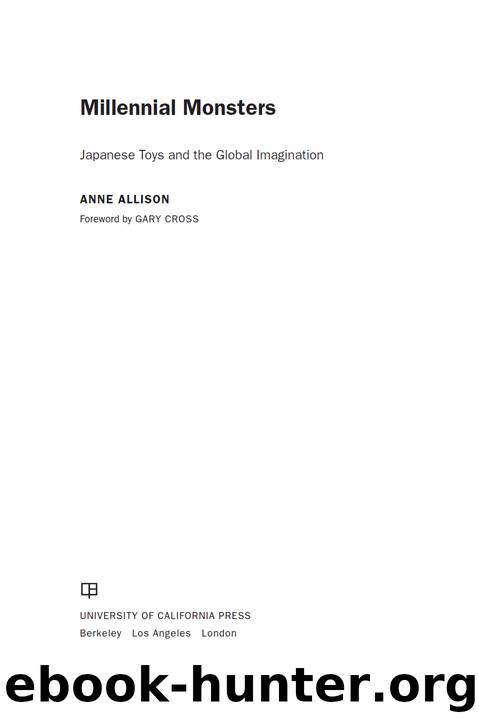Millennial Monsters by Cross Gary Allison Anne

Author:Cross, Gary, Allison, Anne
Language: eng
Format: epub
Publisher: University of California Press
Published: 2006-03-14T16:00:00+00:00
Fragmentation of Demand:
The Globalization of Sailor Moon
The model of “fashion action” developed by the product(ion) of Sailor Moon and trafficked as kids’/girls’ mass culture in the global marketplace in the 1990s did exceedingly well in a number of places—Singapore, Hong Kong, Taiwan, Malaysia, Mexico, Spain, France, Canada, and Switzerland—in a business as lucrative as it is quixotic, given its play in the territory of desire and the imagination. Trading in toys, television shows, morphing, and superheroes, Bandai calls its business that of “fashion”: the popularization and commodification of styles, tastes, and fads. Since its worldwide success with Power Rangers, Bandai has attempted to deterritorialize this business away from Japan. Going “beyond national boundaries” to become, as it now identifies itself, “a global entertainment enterprise” (Bandai Kabushikigaisha 1999:1, 3), Bandai aims to create character merchandise that will appeal to kids around the world. In the case of Sailor Moon, the product involved characters that moved beyond a number of national borders into the marketplaces and imaginations of millions of non-Japanese hosts. Its failure to do this in the United States at the mass level (thereby constituting a commercial success) is significant. But so is the fact that, in the aftermath of this “flop,” Sailor Moon generated an active cult following among American kids.
While Sailor Moon received a mixed reception in the U.S. marketplace, it has achieved global popularity unlike any other product in girls’ mass culture outside the fashion doll Barbie. Even in the United States, as we have seen, the show made greater inroads into the territory of the imagination (linked as this is to the slippery borders of body, identity, and desire) than was thought possible for a Japanese-made fantasy/product. Why did this property manage to take off around the world, becoming the type of (action/fashion) “girl” that once was Barbie’s sole prerogative? Its appeal, I have argued, rests in the way action is articulated with and as fashion, changing both the type of “girl” who is (re)presented and the type of “girl” (which includes many boys) who consumes, and identifies with, these characters. This new “girl” is highly flexible: multiple characters who shift in space and time, alternate between heroism and watching their weight, and have bodies with (inter)changeable parts (tiaras that double as decoration and projectile weapons, for example). Action propels these girls into their fashionable display of multiplicity; their powers are activated and their bodies shape-shift as a preparation for battle. Identity is decentered from any one modality/body and is fragmented into multiple pieces that girls around the world can mix and match when they “play” Sailor Moon. This feature is a major factor in Sailor Moon’s global appeal. It also makes play and identification a pursuit ever more linked to consumerism. Choosing from the plethora of body and character styles in this show resembles nothing so much as shopping at a mall.
Sailor Moon embodies the cultural logic of post-Fordism: fragmentation, flexibility, customization (just-in-time demand). As a global commodity/culture, then, it carries a different fantasy and a different politics than the more Fordist model.
Download
This site does not store any files on its server. We only index and link to content provided by other sites. Please contact the content providers to delete copyright contents if any and email us, we'll remove relevant links or contents immediately.
| Africa | Americas |
| Arctic & Antarctica | Asia |
| Australia & Oceania | Europe |
| Middle East | Russia |
| United States | World |
| Ancient Civilizations | Military |
| Historical Study & Educational Resources |
The Sympathizer by Viet Thanh Nguyen(4344)
The Rape of Nanking by Iris Chang(4169)
World without end by Ken Follett(3446)
Ants Among Elephants by Sujatha Gidla(3442)
Blood and Sand by Alex Von Tunzelmann(3168)
Japanese Design by Patricia J. Graham(3139)
The Queen of Nothing by Holly Black(2545)
City of Djinns: a year in Delhi by William Dalrymple(2533)
Foreign Devils on the Silk Road: The Search for the Lost Treasures of Central Asia by Peter Hopkirk(2445)
India's Ancient Past by R.S. Sharma(2433)
Inglorious Empire by Shashi Tharoor(2414)
Tokyo by Rob Goss(2407)
In Order to Live: A North Korean Girl's Journey to Freedom by Yeonmi Park(2362)
Tokyo Geek's Guide: Manga, Anime, Gaming, Cosplay, Toys, Idols & More - The Ultimate Guide to Japan's Otaku Culture by Simone Gianni(2346)
India's biggest cover-up by Dhar Anuj(2336)
The Great Game: On Secret Service in High Asia by Peter Hopkirk(2318)
Goodbye Madame Butterfly(2230)
Batik by Rudolf Smend(2154)
Living Silence in Burma by Christina Fink(2049)
